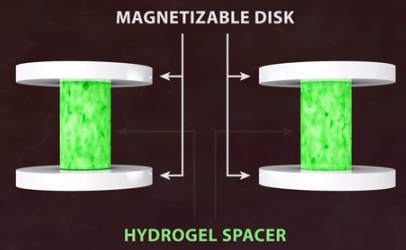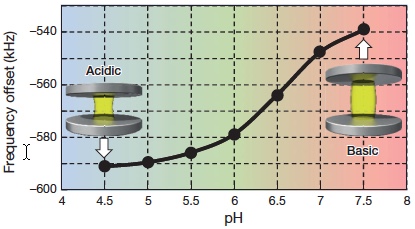High-resolution biosensor can report conditions from deep in the body
March 30, 2015

Geometrically encoded magnetic biosensors (credit: Kelley/NIST PML)
A new microscopic shape-shifting probe capable of sensitive, high-resolution remote biological sensing has been developed by scientists at the National Institute of Standards and Technology (NIST) and the National Institutes of Health (NIH).
If eventually put into widespread use, the design could have a major impact on research in medicine, chemistry, biology, and engineering and ultimately used in clinical diagnostics, according to the researchers.
To date, most efforts to image highly localized biochemical conditions such as abnormal pH* and ion concentration — critical markers for many disorders — rely on various types of nanosensors that are probed using light at optical frequencies.
But the light doesn’t reach far into the body, so the sensitivity and resolution of the resulting optical signals decrease rapidly with increasing depth into the body. That has limited most applications to more optically accessible regions.
Deep-tissue detection
The new probe devices, described online in the journal Nature, are not subject to those limitations. They make it possible to detect and measure localized conditions on the molecular scale deep within tissues, and to observe how they change in real time.
“Instead of optically based sensing, the shape-changing probes are designed to operate in the radio frequency (RF) spectrum, specifically to be detectable with standard nuclear magnetic resonance (NMR) or magnetic resonance imaging (MRI) equipment,” says NIST’s Gary Zabow, who led the research with NIH colleagues Stephen Dodd and Alan Koretsky. “In these RF ranges, signals are … not appreciably weakened by intervening biological materials.”

Local biochemical conditions—such as a change in acidity near inflammation sites—change the length of the hydrogel, causing a detectable change in nuclear magnetic resonance frequency (credit: G. Zabow et al./Nature)
The novel devices, called geometrically encoded magnetic sensors (GEMs), are microengineered metal-gel sandwiches about 5 to 10 times smaller than a single red blood cell, one of the smallest human cells. Each consists of two separate magnetic disks that range from 0.5 to 2 micrometers (millionths of a meter) in diameter and are just tens of nanometers (billionths of a meter) thick (see animation below).
Between the disks is a spacer layer of hydrogel,** a polymer network that can absorb water and expand significantly; the amount of expansion depends on the chemical properties of the gel and the environment around it. Conversely, it can also shrink in response to changing local conditions.
Swelling or shrinking of the gel changes the distance (and the magnetic field strength) between the two disks, and that, in turn, changes the frequency at which the protons in water molecules around and inside the gel resonate in response to radio-frequency radiation. Scanning the sample with a range of frequencies quickly identifies the current shape of the nanoprobes, effectively measuring the remote conditions through the changes in resonance frequencies caused by the shape-changing agents.
In the experiments reported in Nature, the scientists tested the sensors in solutions of varying pH, in solutions with ion concentration gradients, and in a liquid growth medium containing living canine kidney cells as their metabolism went from normal to nonfunctional in the absence of oxygen.
Tracking cancer pH clues
That phenomenon caused the growth medium to acidify, and the change over time was sensed by the GEMs and recorded through real-time shifting in resonant frequencies. The frequency shifts resulting from changes in pH were easily resolvable and orders of magnitude larger than any equivalent frequency shifting observed through traditional magnetic resonance spectroscopy approaches.
Tracking highly localized pH values in living organisms can be difficult. (A blood test cannot necessarily do it because the sample mixes blood from numerous locations.) Yet local pH changes can provide invaluable early signals of many pathologies. For example, the pH around a cancer cell is slightly lower than normal, and internal inflammation generally leads to local change in pH level. Detecting such changes might reveal, for example, the presence of an unseen tumor or show whether an infection has developed around a surgical implant.
Biomedical uses would require, among other things, further miniaturization. The 0.5 to 2 µm diameter GEMs in the experiments are already small enough for many in vitro and other possible non-biological applications, as well as possibly for some in vivo cellular related applications. But preliminary estimates by the experimenters indicate that the sensors can be reduced substantially from their current size, and might conceivably be made smaller than 100 nanometers in diameter. That would open up many additional biomedical applications.
Tuning for different pathologies
One of the most significant features of GEMs is that they can be “tuned” in fabrication to respond to different biochemical states and to resonate in different parts of the RF spectrum by altering the gel composition and the magnet shapes and materials, respectively.
So placing two different populations of GEMs at the same site makes it possible to track changes in two different variables at the same time — a capability the researchers demonstrated by placing GEMs with two different dimensions in the same location and detecting the signals from both simultaneously.
“The idea is that you could design different sensors to measure different things, effectively measuring a panel of potential biomarkers simultaneously, rather than just one, to better differentiate between different pathologies,” Zabow says. “We think that these sensors can potentially be adapted to measure a variety of different biomarkers, possibly including things such as glucose, local temperatures, various ion concentrations, possibly the presence or absence of various enzymes.”
NIST PML | New Biosensor
* pH is a measure of the acidity or alkalinity of a substance, on a scale ranging from 0 (highly acidic) to 14 (highly alkaline). 7 is neutral. Human blood is normally around 7.4.
** Hydrogels are cross-linked networks of polymers that can absorb various amounts of water depending on their chemical composition and structure. The hydrogels used in the NIST-NIH project were engineered to swell in neutral environments and to shrink in low-pH environments.
Abstract of Shape-changing magnetic assemblies as high-sensitivity NMR-readable nanoprobes
Fluorescent and plasmonic labels and sensors have revolutionized molecular biology, helping visualize cellular and biomolecular processes. Increasingly, such probes are now being designed to respond to wavelengths in the near-infrared region, where reduced tissue autofluorescence and photon attenuation enable subsurface in vivo sensing. But even in the near-infrared region, optical resolution and sensitivity decrease rapidly with increasing depth. Here we present a sensor design that obviates the need for optical addressability by operating in the nuclear magnetic resonance (NMR) radio-frequency spectrum, where signal attenuation and distortion by tissue and biological media are negligible, where background interferences vanish, and where sensors can be spatially located using standard magnetic resonance imaging (MRI) equipment. The radio-frequency-addressable sensor assemblies presented here comprise pairs of magnetic disks spaced by swellable hydrogel material; they reversibly reconfigure in rapid response to chosen stimuli, to give geometry-dependent, dynamic NMR spectral signatures. The sensors can be made from biocompatible materials, are themselves detectable down to low concentrations, and offer potential responsive NMR spectral shifts that are close to a million times greater than those of traditional magnetic resonance spectroscopies. Inherent adaptability should allow such shape-changing systems to measure numerous different environmental and physiological indicators, thus providing broadly generalizable, MRI-compatible, radio-frequency analogues to optically based probes for use in basic chemical, biological, medical and engineering research.